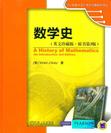数学史
出版时间:2012-6 出版社:机械工业出版社 作者:卡兹 页数:976 字数:1562000
Tag标签:无
内容概要
本书配有翻译成中文的前言和目录,采用特种纸双色印刷,主要包含小学、中学以及大学所涉及的数学内容的历史。本书将数学史按照年代顺序划分成若干时期,每一时期介绍多个专题。本书的前半部分内容是讲述公元前直到17世纪末微积分发明为止的这一时期的历史,后半部分内容则介绍18世纪至20世纪的数学发展。详细内容可参考中文目录。
《数学史(英文珍藏版·原书第3版)》适合所有对数学的来龙去脉感兴趣的读者。正在学习数学的学生通过本书可以更深入地了解数学的发展过程。教师不仅可以使用本书讲解专门的数学史课程,而且可以在其他和数学相关的课程中使用本书的内容。
书籍目录
序言
第一篇 古代数学
第1章 埃及和美索不达米亚
1.1 埃及
1.2 美索不达米亚
1.3 结论
习题
参考文献和注解
第2章 希腊数学的开始
2.1 最早的希腊数学
2.2 柏拉图时期
2.3 亚里士多德
习题
参考文献和注解
第3章 欧几里得
3.1 《几何原本》简介
3.2 第一卷与毕达哥拉斯定理
3.3 第二卷与几何代数
3.4 圆与多边形作图
3.5 比与比例
3.6 数论
3.7 无理量
3.8 立体几何与穷竭法
3.9 欧几里得的《已知数》
习题
参考文献和注解
第4章 阿基米德与阿波罗尼
4.1 阿基米德和物理学
4.2 阿基米德和数值计算
4.3 阿基米德与几何
4.4 阿波罗尼之前的圆锥曲线研究
4.5 阿波罗尼的《圆锥曲线论》
习题
参考文献和注解
第5章 古希腊时代的数学方法
5.1 托勒密之前的天文学
5.2 托勒密与《天文学大成》
5.3 实用数学
习题
参考文献和注解
第6章 希腊数学的末章
6.1 尼可马霍斯和初等数论
6.2 丢番图和希腊代数
6.3 帕普斯与分析
6.4 希帕蒂娅与希腊数学的结束
习题
参考文献和注解
第二篇 中世纪数学
第7章 古代与中世纪的中国
7.1 中国数学简介
7.2 计算
7.3 几何
7.4 解方程
7.5 不定分析
7.6 中国数学的传播与交流
习题
参考文献和注解
第8章 古代与中世纪的印度
8.1 印度数学简介
8.2 计算
8.3 几何
8.4 解方程
8.5 不定分析
8.6 组合学
8.7 三角学
8.8 印度数学的传播与交流
习题
参考文献和注解
第9章 伊斯兰数学
9.1 伊斯兰数学简介
9.2 十进制算术
9.3 代数
9.4 组合学
9.5 几何学
9.6 三角学
9.7 伊斯兰数学的传播与交流
习题
参考文献和注解
第10章 中世纪的欧洲数学
10.1 中世纪欧洲数学简介
10.2 几何学和三角学
10.3 组合学
10.4 中世纪的代数
10.5 运动学的数学
习题
参考文献和注解
第11章 世界各地的数学
11.1 14世纪转折时期的数学
11.2 美洲、非洲以及太平洋地区的数学
习题
参考文献和注解
第三篇 早期近代数学
第12章 文艺复兴时期的代数
12.1 意大利的算图学家
12.2 法国、德国、英国和葡萄牙的代数
12.3 三次方程的求解
12.4 韦达、代数符号和分析
12.5 西蒙·斯蒂文与十进分数
习题
参考文献和注解
第13章 文艺复兴时期的数学方法
13.1 透视学
13.2 航海与地理学
13.3 天文学和三角学
13.4 对数
13.5 运动学
习题
参考文献和注解
第14章 17世纪的代数、几何和概率
14.1 方程论
14.2 解析几何
14.3 初等概率论
14.4 数论
14.5 射影几何
习题
参考文献和注解
第15章 微积分的开端
15.1 切线和极值
15.2 面积和体积
15.3 曲线求长法和基本定理
习题
参考文献和注解
第16章 牛顿和莱布尼茨
16.1 伊萨克·牛顿
16.2 戈特弗里德·威廉·莱布尼茨
16.3 最初的微积分教科书
习题
参考文献和注解
第四篇 近代数学
第17章 18世纪的分析学
17.1 微分方程
17.2 多元微积分学
17.3 微积分学教科书
17.4 微积分学的基础
习题
参考文献和注解
第18章 18世纪的概率论和统计学
18.1 理论概率论
18.2 统计推断
18.3 概率论的应用
习题
参考文献和注解
第19章 18世纪的代数和数论
19.1 代数教科书
19.2 方程论的进展
19.3 数论
19.4 美洲的数学
习题
参考文献和注解
第20章 18世纪的几何
20.1 克莱罗与《几何基础》
20.2 平行公设
20.3 解析几何和微分几何
20.4 拓扑学的开始
20.5 法国大革命与数学教育
习题
参考文献和注解
第21章 19世纪的代数和数论
21.1 数论
21.2 解代数方程
21.3 符号代数
21.4 矩阵和线性方程组
21.5 群和域--结构研究的开始
习题
参考文献和注解
第22章 19世纪的分析
22.1 分析的严谨性
22.2 分析的算术化
22.3 复分析
22.4 向量分析
习题
参考文献和注解
第23章 19世纪的概率论和统计学
23.1 最小二乘法与概率分布
23.2 统计学与社会科学
23.3 统计图
习题
参考文献和注解
第24章 19世纪的几何学
24.1 微分几何学
24.2 非欧几里得几何
24.3 射影几何
24.4 图论与四色问题
24.5 n维几何
24.6 几何基础
习题
参考文献和注解
第25章 20世纪以来的数学
25.1 集合论:问题和悖论
25.2 拓扑学
25.3 代数方面的新思想
25.4 统计革命
25.5 计算机及其应用
25.6 被攻克的老问题
习题
参考文献和注解
附录A 如何在数学教学中使用本书
A.1 课程与选题
A.2 融入数学史的示范课概念
A.3 大事年表
数学史总参考文献
部分习题答案
索引和发音提示
数学家年表
章节摘录
Pappus's Book 7,then,is a companion to the Domain of Analysis,which itself consists of several geometric treatises,all written many centuries before Pappus.These works,Apollonius's Conics and six other books(all but one lost),Euclid's Data and two other lost works,and single works(both lost)by Aristaeus and Eratosthenes,even though the last-named au thor is not mentioned in Pappus's introduction,provided the Greek mathematician with the tools necessary to solve problems by analysis.For example,to deal with problems that result in conic sections,one needs to be familiar with Apollonius's work.To deal with problems solvable by"Euclidean"methods,the material in the Data is essential.Pappus's work does not include the Domain of Analysis itself.It is designed only to be read along with these treatises.Therefore,it includes a general introduction to most of the individual books along with a large collection of lemmas that are intended to help the reader work through the actual texts.Pappus evidently decided that the texts themselves were too difficult for most readers of his day to understand as they stood.The teaching tradition had been weakened through the centuries,and there were few,like Pappus,who could appreciate these several-hundred-year-old works.Pappus's goal was to increase the numbers who could understand the mathematics in these classical works by helping his readers through the steps where the authors wrote"clearly...!"He also included various supplementary results as well as additional cases and alternative proofs.Among these additional remarks is the generalization of the three-and four-line locus problems discussed by Apollonius.Pappus noted that in that problem itself the locus is a conic section.But,he says,if there are more than four lines,the loci are as yet unknown; that is,"their origins and properties are not yet known."He was disappointed that no one had given the construction of these curves that satisfy the five-and six-line locus.The problem in these cases is,given five(six)straight lines,to find the locus of a point such that the rectangular parallelepiped contained by the lines drawn at given angles to three of these lines has a given ratio to the rectangular parallelepiped contained by the remaining two lines and some given line(remaining three lines).Pappus noted that one can even generalize the problem further to more than six lines,but in that case,"one can no longer say ‘the ratio is given between some figure contained by four of them to some figure contained by the remainder'since no figure can be contained in more than three dimensions."Nevertheless,according to Pappus,one can express this ratio of products by compounding the ratios that individual lines have to one another,so that one can in fact consider the problem for any number of lines.But,Pappus omplained,"(geometers)have by no means solved(the multi-line locus problem)to the extent that the curve can be recognized....The men who study these matters are not of the same quality as the ancients and the best writers.Seeing that all geometers are occupied with the first principles of mathematics...and being ashamed to pursue such topics myself,I have proved propositions of much greater importance and utility."
图书封面
图书标签Tags
无
评论、评分、阅读与下载
用户评论 (总计2条)
- 非常好的一本数学史资料,值得珍藏和阅读。
- 很好,珍藏,不过可惜是英文的,还需恶补英文呀
